Per definire un lavoro perfettamente eseguito si dice che è fatto ad arte. Paolo Ballerani è cresciuto con un padre, Gualtiero, che "ad arte" ha sempre fatto sculture. È con orgoglio evidente che Paolo parla di colui che gli ha fatto amare e studiare l'arte e la scultura e del quale conserva lavori di grande perfezione e bellezza. Così accanto alla sua apprezzatissima e prestigiosa attività di creatore di allestimenti in tutto il mondo (oltre che alla Galleria Nazionale dell'Umbria) fa sculture e bassorilievi ed affida ad essi l'espressione dei suoi pensieri più importanti e profondi.
Un soggetto da lui prediletto è sempre stato il cavallo, un messaggio di bellezza nelle linee naturalmente eleganti, ma che tendono ad allontanarsi dal reale per avventurarsi verso ardite astrazioni. Le criniere in particolare si espandono come fuochi d'artificio o formano volute e giocano con lo spazio come panneggi angelici nei dipinti manieristi e barocchi. Ne scaturisce un anelito intenso allo spazio e alla libertà, un messaggio positivo di energia interiore che fluisce lungo linee dinamiche che si vanno espandendo. Sono percorse dalla luce grazie alle laccature e patine che Paolo utilizza con effetti che vanno dal bronzo all'alabastro al marmo bianco e all'oro e all'argento. Ma in quelle criniere pettinate dal vento si percepisce anche il flusso del tempo che lascia solchi profondi e ferite dove questi costruiscono una nuova armonia piena di senso.
Non ha mai avuto paura delle grandi dimensioni, delle altezze e dei vasti spazi. Il grande cavallo della Rocca Paolina che si impenna sotto le volte del Sangallo sembra ribellarsi contro quella chiusura e l'oppressione che essa rappresentava. Irradia dalle sue superfici dorate l'aspirazione alla libertà e alla luce come un simbolo che riassume la storia della città di Perugia e il suo lungo servaggio.

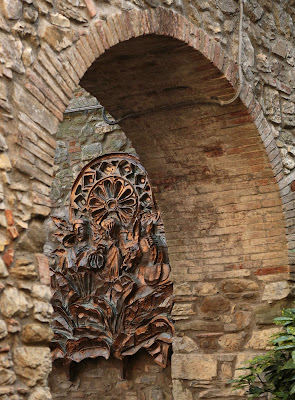
Anche il bassorilievo per Mugnano racconta una storia antica, cara a quel paese ma anche al passato rurale dell'Umbria. Collocata presso l'arco dal quale passavano le raccoglitrici del tabacco, ne ripercorre il cammino e le fa tornare. Le grandi morbide foglie in primo piano lasciano emergere, come da un lago mosso e vitale, i visi dai lineamenti classici e forti, i fazzoletti semplici legati proteggere i capelli. Segue l'asino con la soma, animale oggi in via di estinzione, con il suo muso buono, gli occhi dolcissimi e il suo raglio sgraziato ma familiare nella campagna. In terzo piano il rosone romanico, perché i monasteri hanno costruito la civiltà medievale e il lavoro e il sudore hanno sempre avuto come sfondo la bellezza architettonica. Una ciminiera in lontananza presagisce il futuro che cambierà quella vita stagliandosi con sua rigida geometria. Meditazione sul tempo e sulla storia, sulla fatica e sulla bellezza del passato, la patina antica aggiunge poesia alla figurazione e la colloca in uno spazio che è della mente e del cuore.
Un gesto commovente lega il Cavaliere Stanco al suo cavallo. Si appoggia ad esso e china il suo capo coperto dall'elmo. L'armatura non nasconde la sua fragilità. La spada ha spaccato il rosone, i valori per cui ha combattuto sono infranti. Lo sostiene solo il cavallo, la fedeltà dell'amicizia senza parole, e una rosa che la mano porge racconta il desiderio di pace e d'amore. Qui i sentimenti improntano l'opera e l'emozione traspare da ogni dettaglio in una sintesi di pura poesia.
La fantasia di Paolo va a briglia sciolta come i suoi cavalli, prende il volo con la vastità della criniera che si dispiega nel vento, un vento metafisico e simbolico che fa pensare all'avventura, alla corsa verso la vita con lo slancio del coraggio e della ragione. La ragione, sì, perché la forma si espande nell'aria ma non si sgretola, non perde i connotati della realtà, realtà sognata e stilizzata, ma non negata e confusa. La sua scultura ha radici solide ed eleganti, colte e preziose, dalle quali dispiega le ali e lascia fluire linee melodiose, suscitando emozione e facendo vibrare di luce la materia.
 |
| Bassorilievo in marmo di Gualtiero Ballerani |
Free Rein
Paolo Ballerani working artfullyTo define a perfectly executed work it is said that it is done artfully. Paolo Ballerani grew up with his father, Gualtiero, who "artfully" has always made sculptures. It is with evident pride that Paolo speaks of the one who made him love and study art and sculpture and of whom he keeps works of great perfection and beauty. So alongside his highly appreciated and prestigious activity as creator of installations all over the world (and at the National Gallery of Umbria) he makes sculptures and bas-reliefs and entrusts them with the expression of his most important and profound thoughts.
The horse has always been a favorite subject for him, a message of beauty in naturally elegant lines, which tend to move away from reality to venture towards bold abstractions. Manes in particular expand like fireworks or form volutes and play with space like angelic draperies in mannerist and baroque paintings. The result is an intense yearning for space and freedom, a positive message of inner energy that flows along dynamic lines that are soaring. They are intensified by light thanks to the lacquering and glazes that Paolo uses with effects ranging from bronze to alabaster to white marble and gold and silver. But in those manes combed by the wind you can also perceive the flow of time that leaves deep furrows and wounds and builds a new harmony full of meaning.
He was never afraid of large sizes, heights and vast spaces. The large horse of the Rocca Paolina that rears up under the Sangallo vaults seems to rebel against that closure and the oppression it represented. The aspiration to freedom and light radiates from its golden surfaces as a symbol that sums up the history of the city of Perugia and its long servitude.
The awareness of past history and cultural values gives unity to the large bas-relief of the Posta dei Donini in San Martino in Campo. There are the most significant and beautiful monuments of his homeland described as in a sequence shot, the forms that Paolo always loved and studied like the rose windows which in their perfect shape fix transcendent and eternal values into stone.
The bas-relief for Mugnano also tells an ancient story, dear to that village but also to the rural past of Umbria. Placed near the arch through which the tobacco pickers passed, it traces the path and makes them return. The large soft leaves in the foreground let emerge, as from a rough and vital lake, their classic and strong features and the simple handkerchiefs tied to protect their hair. Follows a donkey, animal near extinction today, with its good face, the sweetest eyes and its graceless but familiar bray in the countryside. Behind it you see the Romanesque rose window, because the monasteries built medieval civilization while work and sweat have always had architectural beauty as a background. A chimney in the distance foreshadows the future that will change that life by standing with its rigid geometry.
Meditation on time and history, on the fatigue and beauty of the past, the ancient patina adds poetry to the figuration and places it in a space that is of mind and heart.
A moving gesture binds the Tired Knight to his horse. He leans against it and bends his head covered by an helmet. His armor does not hide his fragility. A sword broke the rose window, the values for which he fought are broken. Only his horse sustains him, the fidelity of friendship without words, and a rose that his hand holds out tells the desire for peace and love. Here feelings shape the sculpture and the emotion shines through every detail in a synthesis of pure poetry.
Paolo's imagination goes as loose as his horses, takes flight with the vastness of manes that unfold in the wind, a metaphysical and symbolic wind that evokes adventure, racing towards life with the enthusiasm of courage and reason. Reason, yes, because the forms expand in the air but never crumble nor lose the connotations of reality, dreamed and stylized reality, but never denied and confused. His sculpture has solid and elegant roots, cultured and precious, from which it spreads its wings and lets melodious lines flow, arousing emotion and vibrating with light.


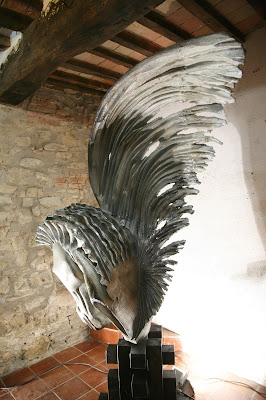

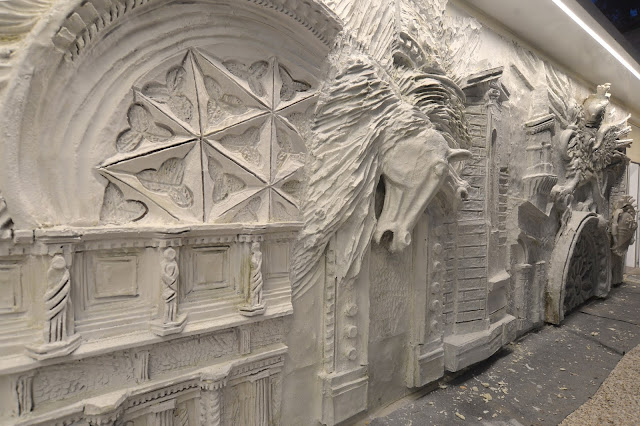










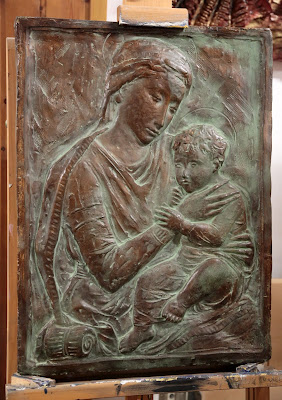



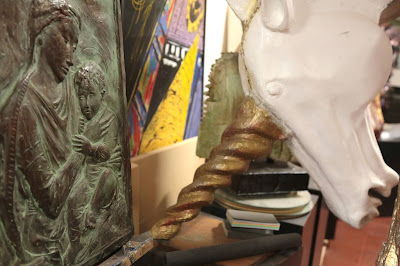
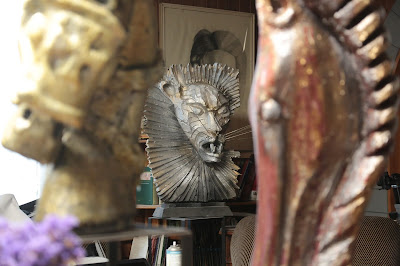

Nessun commento:
Posta un commento
Nota. Solo i membri di questo blog possono postare un commento.